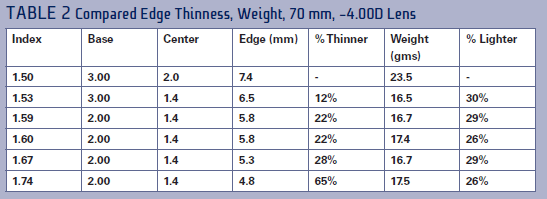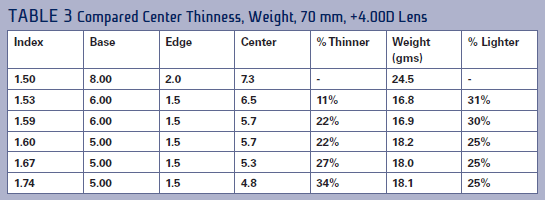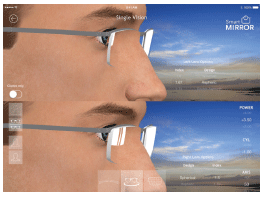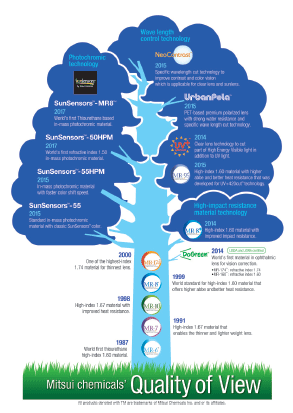MR MATERIAL:
Premium, Clear, Strong, Thin, With Visual Appeal and Integrity
By Mark Mattison-Shupnick, ABOM
Release Date: March 1, 2017
Expiration Date: April 1, 2018
Learning Objectives
Upon completion of this program, the participant should be able to:
- Understand why your lens suppliers choose the high-index materials they do.
- Learn how a combination of material characteristics creates a more merchandisable finished lens on which you can rely.
- Develop a new set of words that better describes the underlying DNA of lenses and the material they're made from for customer discussions.
 Mark Mattison-Shupnick, ABOM, is currently director of education for Jobson Medical Information LLC, has over 47 years of experience as an optician, was senior staff member of SOLA International and is a frequent lecturer and trainer.
Mark Mattison-Shupnick, ABOM, is currently director of education for Jobson Medical Information LLC, has over 47 years of experience as an optician, was senior staff member of SOLA International and is a frequent lecturer and trainer.
Credit Statement
This course is approved for one (1) hour of CE credit by the American Board of Opticianry (ABO). Technical Level 2. Course STWJM1657-2
This course is supported by an educational grant from MITSUI CHEMICALS INC.
Lens manufacturers choose lens materials and their raw chemical suppliers because of the products that they can manufacture that deliver superior lens attributes in final lens form. Those lenses must provide a promise of market preference and market success. Labs choose lens materials because of ECP demand and product sales opportunities but require in-lab processing efficiency and superior surface quality. ECPs choose lens materials because they are the foundation of the final lens that delivers patient satisfaction and saleable benefits. Each also requires an opportunity to make a profit. This course teaches the DNA of the Mitsui MR Series of premium high-index lens materials and why they’ve become a standard by which lens material choice is measured.
Did you know that almost 6 of every 10 pairs of glasses sold in the U.S. today have lenses that boast the wearer benefits of thinner, lighter, more impact resistant lenses and are 100 percent UV absorptive? Opticians make this conscious choice of benefits built in when choosing lens materials for patients. However, the balance of material properties has some opticians preferring one material class over another.
When asked why opticians choose “premium high-index,” they suggest that the higher refractive index makes for thinner, better looking lenses, a higher Abbe number and surface finish ensures clarity. The high impact and reduced notch sensitivity or tensile strength makes them also perfect for rimless. How have high-index lenses evolved, and what makes them a lens material choice that supports the best of premium eyewear?
THE CHANGE FROM GLASS TO LIGHTER LENSES
The evolution of non-glass spectacle lenses has its roots in the 1940s with the invention of CR-39 monomer as a liner for B-17 bomber fuel tanks. The idea of making CR-39 lenses from this PPG material became a manufacturing possibility in the late 1940s. In 1972, an impact resistance standard became a Federal requirement as FDA 21CFR801.410(c)(3). U.S. opticians were required (as you are today) to dispense only lenses that pass a drop ball test (or can be shown by sampling to pass). Plastic lenses were an advantage since they didn’t require a surface chemical treatment or heat tempering like glass to improve impact strength. In addition, they were half the weight of glass lenses. Add the opportunity to make larger, lighter lenses, and that allowed frame manufacturers the option of larger frames. Plastic lens sales took off; glass crashed. However, while lighter, these original plastic lenses were also thicker than their glass counterparts because of the lower index. They could be better—enter human invention.

Today, we take for granted the option of choosing higher index plastic lenses. In fact, high-index lenses provide 90 percent of the “extra” lens characteristics most valued by consumers once, of course, clear vision has been assured. As shown in the annual VisionWatch survey of more than 120,000 consumers, the lens benefits most valued by consumers are thinness, durability (scratch resistance) and protection (UV and impact). So what should we know about the modern premium high-index lens?
MITSUI CHEMICALS INC.
First, I think it’s important to know about those companies behind the scenes who spend vigorously to research and develop lens material monomers and the many ways they have improved our ability to serve the eyeglass wearing public.
Mitsui Chemicals is the world’s majority producer of high-index lens monomers for the lens casters that your lab uses regularly. Finished lenses and semi-finished lens blanks are made from the MR Series of lens materials manufactured by Mitsui Chemicals in Japan. Each lens caster sources the monomer components to produce a portfolio of 1.60, 1.67 and 1.74 high-index lenses. Take a look at the contemporary material choices you make every day, listed in Table 1.
I’m sure that you’re familiar with the numbers for index, specific gravity and Abbe, but how do heat distortion, tintability, impact and rimless use affect the choices that you make?
How do your choices affect the way that lens materials have been developed, and what are the questions that the lab and the manufacturer ask when choosing material offerings?
IT’S A BALANCE
When reviewing the table above, it’s easy to look at one line of properties, “index” for example and let that suggest the best lens material for all patients or prescriptions. However, as you know, that is not the case. For example, in minus lenses, final lens edge thinness is not a function of only index but rather the lens size (the result of the frame’s boxed dimensions and the patient’s PD and fitting height required), the starting base curve (steeper curves result in thicker lens edges), refractive index (higher indices make thinner lens edges) and allowable minimum center thickness (a function of impact resistance directly reduces edge thinness). Tables 2 and 3 are comparisons of thinness and weight that use the data from Table 1, but consider the resulting lens as a function of all the factors of base curve, center thinness, specific gravity and index.


Notice that plastic lenses have slightly steeper base curves and are still created with 2.0 mm centers. While the highest index makes for lenses that are almost half the edge thickness of standard plastic, all indices reduce weight by about 30 percent. Improved impact strength would also allow production of high-index lenses with 1.0 mm or near 1.0 mm centers assuming that the material has good tensile strength and stability at that thinness. That would make for even thinner edges. Therefore, minus lens edge thinness is a function of lens size, index and allowable center thinness. Let’s look at a plus lens example (Table 3).
Plus lens thinness at the center is a function of index, lens size (and shape) and the thinness wanted at the thinnest edge. The thinnest edge is determined by lens shape for the frame chosen and the angle of the effective diameter (ED is twice the longest radius). That’s why your lab always wants the frame to trace when producing plus lenses. Without it, lenses can be made too thin or too thick. That’s certainly the case when using stock finished lenses. In Table 2, high-index lenses deliver to the wearer about 22 to 34 percent thinner and about 25 percent lighter lenses.
What do you do with this information? We use our best judgment and knowledge about lenses; we consult our lab and use thinness calculators to determine which material is the best solution for a patient. This means that choosing material for more than just index is required. What should be your considerations? To answer that question, one must understand a bit of the evolution of high-index and the requirements for the best pair of contemporary eyewear.
A HISTORY OF IMPROVING LENS PROPERTIES
One of the first successful 1.6 high-index lenses introduced was made from MR-6 material (1987). With an index of 1.594, Abbe of 36 and specific gravity of 1.43gms/ cc3, it made for a thinner and lighter lens. This material also had the added benefit that 100 percent UV absorption was built in. At this time polycarbonate lens manufacture was challenging. The lenses produced had internal debris (fines and carbon specks), lenses were yellowed and that required a bluing agent to make them appear grey. There were inconsistent surface curves causing labs to have inconsistent surfacing results. As a result, the race between premium highindex and polycarbonate was on because the ECP and consumer really liked thinner and lighter lenses.
 In 1991, Mitsui introduced MR-7, a 1.67 high-index monomer (Index 1.67, Sp. Gr 1.35gm/cc3, Abbe 31) to yet again help opticians worldwide to reduce lens thinness and weight on behalf of their patients. Initial use of this very high-index material proved that the eyeglass wearing public and the ECPs who sold them appreciated the improved thinner, lighter lens opportunity. 1.67 was quickly adopted and a go-to index for lenses with better cosmetics and comfort.
In 1991, Mitsui introduced MR-7, a 1.67 high-index monomer (Index 1.67, Sp. Gr 1.35gm/cc3, Abbe 31) to yet again help opticians worldwide to reduce lens thinness and weight on behalf of their patients. Initial use of this very high-index material proved that the eyeglass wearing public and the ECPs who sold them appreciated the improved thinner, lighter lens opportunity. 1.67 was quickly adopted and a go-to index for lenses with better cosmetics and comfort.
However, tinting was a problem as lenses tinted quickly but deformed at high tint bath temperatures. In the late ’80s and early ’90s, sun and especially cosmetic tinting was a common lens attribute. Many lenses were also tinted in-office. Tinting therefore required lower bath temperatures reducing lab and especially the optical office’s efficiency. Recognizing the problem and devoting R&D investment and personnel, Mitsui’s work at material improvements and work with casters solved those issues.
Rimless eyewear needs and especially heat resistance for tinting presented a challenge that was met with MR-10 in 1998 (Index 1.67, Sp. Gr. 1.37gm/cc3, Abbe 31). MR-10 improved the properties of MR-7 by delivering a higher transition point for heat distortion (less heat sensitive tinting). MR materials had improved tensile strength for drilled rimless. Rimless was to become very popular through the election in 2008 when consumers and news media commented on vice president candidate Sarah Palin’s Kazuo Kawasaki eyewear. MR-10 materials (except MR-174), when drilled, produces a clean drill hole that will not distort when worn and resists breakage. Anecdotally, MR-10 is known for surfacing efficiency, tinting, increased hard coat options as well as being easier to cast with polarizing film.
 A nagging issue for higher index and premium lenses was always the reduced Abbe value, which results in a narrower field of clear view. That is no longer the case. Beginning in 2003 to 2004, free-form as a calculation method and processing technique was becoming more widespread. The improvements to computing power, machine control, measuring instruments and surfacing equipment provides us an option today where the entire lens surface can be reconstructed addressing all aspects of lens power and fit. As a result, Abbe can be made a small issue affecting lens clarity off center.
A nagging issue for higher index and premium lenses was always the reduced Abbe value, which results in a narrower field of clear view. That is no longer the case. Beginning in 2003 to 2004, free-form as a calculation method and processing technique was becoming more widespread. The improvements to computing power, machine control, measuring instruments and surfacing equipment provides us an option today where the entire lens surface can be reconstructed addressing all aspects of lens power and fit. As a result, Abbe can be made a small issue affecting lens clarity off center.
The improvements to thinness and lightness, absorption of UV, options for larger trendy frames, improved impact and durability for the eyeglass wearing customer makes a small amount of peripheral blur a very worthwhile trade-off. In fact, it is usually possible for a customized 1.67 high-index lens using position of wear measurements to outperform an out of the envelope plastic stock lens visually as well as significantly improve cosmetics.
During this time there were two other high-index materials released to be part of the optician’s toolbox. In 1999, MR-8 was released (Index 1.60, Sp. Gr. 1.30, Abbe 41) and over time effectively replaced MR-6. This allowed opticians a material with an Abbe of over 40 to produce prescription lenses with superior clarity across the entire lens surface. In addition, heat resistance for tinting capability was also significantly improved. Then MR-174 was made commercial in 2000 (Index 1.74, Sp. Gr. 1.47, Abbe 32). These two materials changed the portfolio of many casters and that made for you, the optician, a series of lens choices available to separate yourself from others.
 Today, the MR-174 is 80 to 90 percent biomass whose proportions are Biobased Carbon versus Fossil Based Carbon. This new product is branded, DoGreen and replaced the original 1.74 to add value to the use of these lenses for both the ECP and consumer, all without additional cost to the casting company. Giving back must be a part of every manufacturing organization today, and this high-index has been tuned to meet social responsibility.
Today, the MR-174 is 80 to 90 percent biomass whose proportions are Biobased Carbon versus Fossil Based Carbon. This new product is branded, DoGreen and replaced the original 1.74 to add value to the use of these lenses for both the ECP and consumer, all without additional cost to the casting company. Giving back must be a part of every manufacturing organization today, and this high-index has been tuned to meet social responsibility.
LENS COATINGS
When talking about highindex, it’s very important to also describe the evolution of scratch and AR coatings.
 Most hard coats’ index of refraction closely matches standard plastic (hard resin, 1.50). If there is a mismatch between the hard coat’s refractive index and lens refractive index, the result is birefringence.
Most hard coats’ index of refraction closely matches standard plastic (hard resin, 1.50). If there is a mismatch between the hard coat’s refractive index and lens refractive index, the result is birefringence.
Birefringence appears as a rainbow pattern on the lens surface. If the coating and lens have the same index of refraction, the light passing through “sees” the two as one continuous substrate and the reflections at the interface are minimized. Premium high-index lenses use higher index coatings. The result is lenses without the reflective color pattern.
I’ve often seen a question about this on the optometry and optician online forums with some participants speculating a problem with the Abbe of the material. Not so—it’s a lens index mismatch with the coating index.
SDC Technologies Inc., has been part of the lab and lens caster supply chain for more than 30 years providing material and processing inventions and tips. Acquired by Mitsui in 2008, SDC continues to provide premium high quality thermal and UV-cure hard coatings to improve the scratch and abrasion resistance of lenses under the CrystalCoat brand. Remember, improving the durability of the hard coat has three main effects.
First, lens scratch and abrasion resistance is improved. Second, a harder substrate improves any subsequent AR coating. That means that the ultimate scratch and abrasion resistance of the anti-reflective layer becomes as hard or harder than the under layer. Last, all this produces a lens that better exceeds the expectations and value assessment of the wearers and the ECP.
Another of the premium high-index opportunities that you may not know about are that the hard coating applied are in fact two layers. The first layer is a primer that is very sticky to the high-index surface and very sticky to the next hard coating layer.
This allows the hard coating layer to be cured to a harder, more scratch and abrasion resistant surface. This allows, in some manufacturer’s lenses, an AR lens that is as abrasion resistant as glass.
Next, the primer layer is an impact enhancing coating layer.
That means that upon impact, the primer layer will help manage a crack that may be propagating through the lens by diverting through the coating horizontally rather than vertically and slowing it to a stop. The result, in its final form as an AR lens is one that has increased impact resistance, often more than the bare lens by itself.
AR LENSES ARE A MUST
As index increases, so do surface reflections. In 1.50 index, that’s about 4 percent a surface or 8 percent light loss total. Those are the reflections that get in the way of seeing someone’s beautiful eyes or them seeing the entire world that’s intended through their glasses. Increase the index and surface reflections increase because the effect is index dependent.
If a 1.50 index lens passes only about 92 percent of the light, a poly or 1.6 lens pass 90 percent, 1.67 only 88 percent and 174 only 86 percent. In higher minus prescriptions front base curves are flatter, increasing the appearance of surface reflections and in higher plus, reflections off the back can be terribly annoying. That means that high power lenses in higher index materials are always sold as AR lenses. That also means use of index matched hard and AR coats. In fact, I recommend AR for everyone and in high-index, not offer lenses that were only hard coated.
CHOOSING HIGH-INDEX LENSES
Obviously, the question is, “when does one use thinner and lighter lenses?” My experience suggests that anyone with an Rx above ±2D is a candidate, especially considering lens size, the greatest contributor to the lens’ final thickness and weight. Whether that means 1.6, 1.67 or greater than 1.67 is dependent on prescription strength, frame size, PD and fitting height. Then, of course there is that person who is especially sensitive to the visibility of the lens edge or how thick the lens center is and how much it magnifies. Those are the cues to increase index, reduce size, etc.
I’m sure that you’ve been reading the reports about the significant increase of myopia (for example, “The Myopia Boom” at Nature.com by Elie Dolgin, March 18, 2015). If the increase in the number of patients and severity continues, high-index lenses provide the eyewear solution for these patients that also meet a large variety of their cosmetic and protection concerns. Become an expert at understanding and using them.
There are no barriers to using high-index. The prescription population is diverse and about a third have prescriptions greater than 2D where it will make a difference. Improved prescription clarity over the entire lens, using free-form techniques, makes for better eyewear. For low cylinder prescriptions, the use of aspheric lens designs produce better vision with less magnification effects. And there are many series of finished stock lenses where index has been combined with asphericity, double asphericity, index matched coatings, AR and photochromics. There are no barriers.
The VisionWatch survey results confirm that patient satisfaction is improved since consumers request these benefits. And that means an increase of practice profitability. I estimate that in the practice averaging $750K in revenue, doubling high-index, which automatically increases anti-reflective lenses sold, would add about $30K in practice revenue annually. What’s there not to like?
COMMUNICATING THE BENEFITS
 Start the conversation with customers by describing the exact benefits of high-index lenses. Use tools like cross-sections of various powered lenses to demonstrate the advantage and the reason that they cost more. If you have a digital measuring device, it most likely can draw comparisons (see the ABS Smart Mirror CE on demonstrating lens differences).
Start the conversation with customers by describing the exact benefits of high-index lenses. Use tools like cross-sections of various powered lenses to demonstrate the advantage and the reason that they cost more. If you have a digital measuring device, it most likely can draw comparisons (see the ABS Smart Mirror CE on demonstrating lens differences).
Use your personal experience or those of recent patients by saying, “Your prescription is ideal for premium thinner and lighter lenses; I wear them myself (or a number of our patients this week loved them).” Say, “This beautiful frame is complemented by the right lenses. With your prescription and this frame, I recommend...” Or, “For lenses that correct nearsightedness (or farsightedness) and look great too, we use...” And last one, “We start with thinner, lighter and more protective lenses for all of our patients. They cost a little more but our patients prefer the latest in technologies at a reasonable cost.”
Promote lenses and talk about the material from which they are made, that’s differentiable. The facts described in the course can be used as Facebook posts and as snippets on your Web page.
OTHER CONSIDERATIONS
What are the other things we need to know about the MR Series of high-index lenses? All are 100 percent UVA and UVB absorptive. They are available in photochromics and for sunwear in a polarized version, check with your lab for availability. If your office does in-office finishing, a full range of finished S/Ls are produced by a variety of lens casters in diameters, surface designs and with various treatments so that you can maximize efficiency through in-office finishing.
SHIFTING TO MEET CURRENT AND FUTURE CONCERNS—WAVELENGTH CONTROL
 UV+420cut: The MR UV+420cut monomer creates a lens to absorb blue light radiation inherent in the material. This lens pushes the absorption line past the blue-violet to remove potentially harmful radiation. This allows the lens to pass the blue turquoise light that affect sleep patterns while it also allows the use of traditional premium AR. This monomer can be used to make a variety of highindex lenses. See “Blue Light Radiation, a Material Solution” at 2020mag.com/ce.
UV+420cut: The MR UV+420cut monomer creates a lens to absorb blue light radiation inherent in the material. This lens pushes the absorption line past the blue-violet to remove potentially harmful radiation. This allows the lens to pass the blue turquoise light that affect sleep patterns while it also allows the use of traditional premium AR. This monomer can be used to make a variety of highindex lenses. See “Blue Light Radiation, a Material Solution” at 2020mag.com/ce.
NeoContrast: Specialty filters can improve contrast sensitivity. Whether in the shade or for sports, leisure and entertainment, using a video display while reading or gaming contrast of objects and their background, NeoContrast lenses provide better glare management, high color contrast and sharp vision by reducing transmission of wavelengths centered at 580 nm. NeoContrast can be combined with UV+420cut for their combined benefits.
MR8+: MR8+ is a new and more impact resistant version of Mitsui’s MR-8 1.60 monomer that when combined with SDC primer and hardcoats, will pass ANSI Z87.1 safety impact testing. MR8+ has all of the same attributes of MR8, such as a high ABBE value and good tensile strength, but tints quicker than MR-8. Mitsui is looking to have casters launch MR8+ in a full lineup during 2017.
SunSensors MR Series: Mitsui Chemicals acquired SunSensors, photochromic lens materials with refractive index of 1.55, an acrylic-based material from Corning Incorporated, USA in May 2014. Later in 2017, Mitsui Chemicals will expand a new SunSensors product lineup based on the MR series in refractive indices of 1.60 and 1.67 in addition to the conventional 1.50 and 1.55 SunSensors refractive index.
CONCLUSION
Commit to produce better-looking, more protective lenses.
Mitsui Chemicals Inc.’s commitment since 1987 to improving the ophthalmic lens market is evident in the constant introduction and refinement of high-index lens properties.
Patients will appreciate the value of your care and concern when high-index lenses are used and their benefits are clearly defined. To do this, promote thinner and lighter lenses, and talk about the material from which they are made that’s differentiable.



